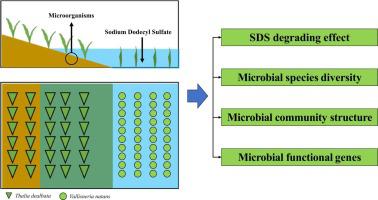当前位置:
X-MOL 学术
›
Environ. Technol. Innov.
›
论文详情
Our official English website, www.x-mol.net, welcomes your
feedback! (Note: you will need to create a separate account there.)
Effect of sodium dodecyl sulfate (SDS) on microbial community structure and function in lake–terrestrial ecotones: A simulation experiment
Environmental Technology & Innovation ( IF 6.7 ) Pub Date : 2024-03-05 , DOI: 10.1016/j.eti.2024.103594 Qi Zhu , Zhenyu Fan , Lingquan Zeng , Chunhua Li , Chun Ye , Ruiwen Zheng
Environmental Technology & Innovation ( IF 6.7 ) Pub Date : 2024-03-05 , DOI: 10.1016/j.eti.2024.103594 Qi Zhu , Zhenyu Fan , Lingquan Zeng , Chunhua Li , Chun Ye , Ruiwen Zheng

|
Even a low concentration of sodium dodecyl sulfate (SDS), a widely used bactericidal surfactant, can significantly change the species, quantity and genetic functions of microorganism communities in natural waters. Lake–terrestrial ecotones are areas where microorganisms are highly active, and they are also the lake areas most vulnerable to SDS pollution. Because microorganisms are very sensitive to environmental changes, their activities vary greatly among lakes and laboratories, so it is difficult to simulate their real dynamics using small-scale experiments. To study the interaction between SDS and microorganisms in a lake–terrestrial ecotone, a large artificial simulation device was used to analyse microbial community structure, phospholipid fatty acid (PLFA) content, gene function and ability to degrade SDS in a lake–terrestrial ecotone contaminated with SDS. The results showed that (1) the period from 2 to 4 days after the beginning of the experiment was the key stage for the biodegradation of SDS. The biodegradation cycle of SDS in the natural environment is shorter than that in small-scale experimental setups, and more than 90% of SDS was removed within 4 days in the simulation device. (2) Low-level SDS pollution (≤ 6 mg/L) has different effects on different types of lacustrine microorganisms. The presence of SDS can lead to a significant decrease in microbial diversity and biomass in lake–terrestrial ecotones with a high density of aquatic plants, but the opposite is true in ecosystems with degraded aquatic plant communities. (3) After SDS pollution occurred, pollution-resistant bacteria such as and became dominant. The relative abundance of carbon cycle functional genes increased rapidly in microorganisms, while the relative abundance of nitrogen cycle functional genes decreased. These changes were not readily reverse even after 20 days, although the communities recovered to a certain extent.
中文翻译:

十二烷基硫酸钠(SDS)对湖陆交错带微生物群落结构和功能的影响:模拟实验
即使是低浓度的十二烷基硫酸钠(SDS)这种广泛使用的杀菌表面活性剂,也可以显着改变自然水域中微生物群落的种类、数量和遗传功能。湖陆交错带是微生物高度活跃的区域,也是最容易受到SDS污染的湖区。由于微生物对环境变化非常敏感,它们的活动在湖泊和实验室之间差异很大,因此很难用小规模的实验来模拟它们的真实动态。为了研究湖陆交错带中SDS与微生物的相互作用,利用大型人工模拟装置,对受污染的湖陆交错带中微生物群落结构、磷脂脂肪酸(PLFA)含量、基因功能和降解SDS的能力进行了分析。与安全数据表。结果表明:(1)实验开始后2~4天是SDS生物降解的关键阶段。 SDS在自然环境中的生物降解周期比小规模实验装置中的生物降解周期短,在模拟装置中4天内90%以上的SDS被去除。 (2)低水平SDS污染(≤6mg/L)对不同类型的湖泊微生物的影响不同。 SDS的存在会导致水生植物密度较高的湖泊-陆地交错带中微生物多样性和生物量显着下降,但在水生植物群落退化的生态系统中情况恰恰相反。 (3)SDS污染发生后, 、 等抗污染细菌占优势。微生物中碳循环功能基因的相对丰度迅速增加,而氮循环功能基因的相对丰度下降。尽管社区得到了一定程度的恢复,但这些变化即使在20天后也没有轻易逆转。
更新日期:2024-03-05
中文翻译:

十二烷基硫酸钠(SDS)对湖陆交错带微生物群落结构和功能的影响:模拟实验
即使是低浓度的十二烷基硫酸钠(SDS)这种广泛使用的杀菌表面活性剂,也可以显着改变自然水域中微生物群落的种类、数量和遗传功能。湖陆交错带是微生物高度活跃的区域,也是最容易受到SDS污染的湖区。由于微生物对环境变化非常敏感,它们的活动在湖泊和实验室之间差异很大,因此很难用小规模的实验来模拟它们的真实动态。为了研究湖陆交错带中SDS与微生物的相互作用,利用大型人工模拟装置,对受污染的湖陆交错带中微生物群落结构、磷脂脂肪酸(PLFA)含量、基因功能和降解SDS的能力进行了分析。与安全数据表。结果表明:(1)实验开始后2~4天是SDS生物降解的关键阶段。 SDS在自然环境中的生物降解周期比小规模实验装置中的生物降解周期短,在模拟装置中4天内90%以上的SDS被去除。 (2)低水平SDS污染(≤6mg/L)对不同类型的湖泊微生物的影响不同。 SDS的存在会导致水生植物密度较高的湖泊-陆地交错带中微生物多样性和生物量显着下降,但在水生植物群落退化的生态系统中情况恰恰相反。 (3)SDS污染发生后, 、 等抗污染细菌占优势。微生物中碳循环功能基因的相对丰度迅速增加,而氮循环功能基因的相对丰度下降。尽管社区得到了一定程度的恢复,但这些变化即使在20天后也没有轻易逆转。































 京公网安备 11010802027423号
京公网安备 11010802027423号